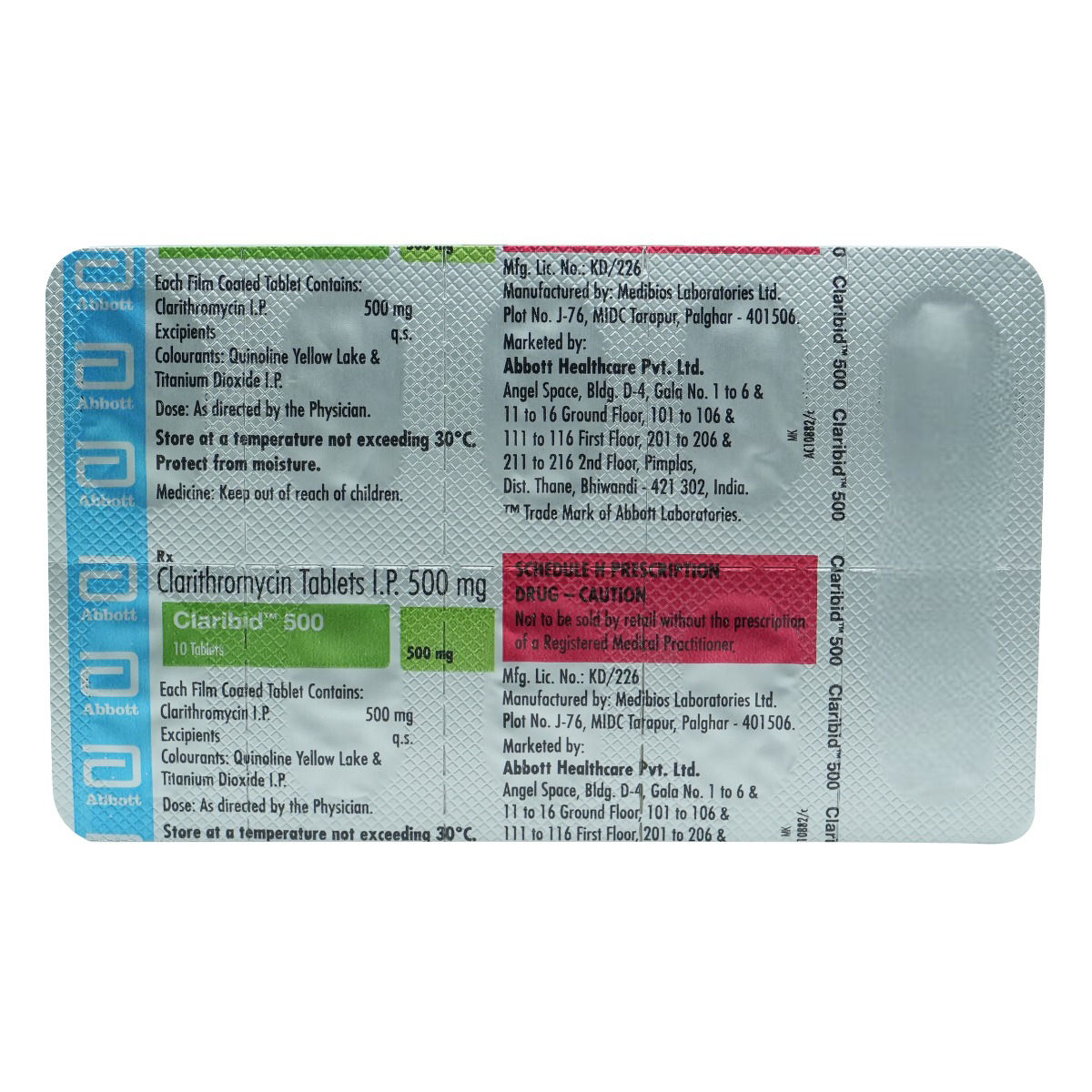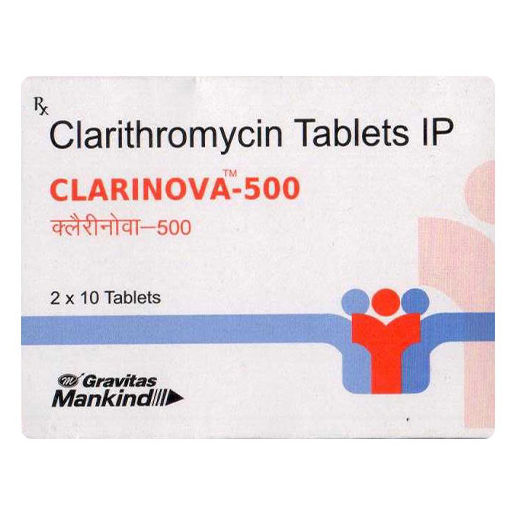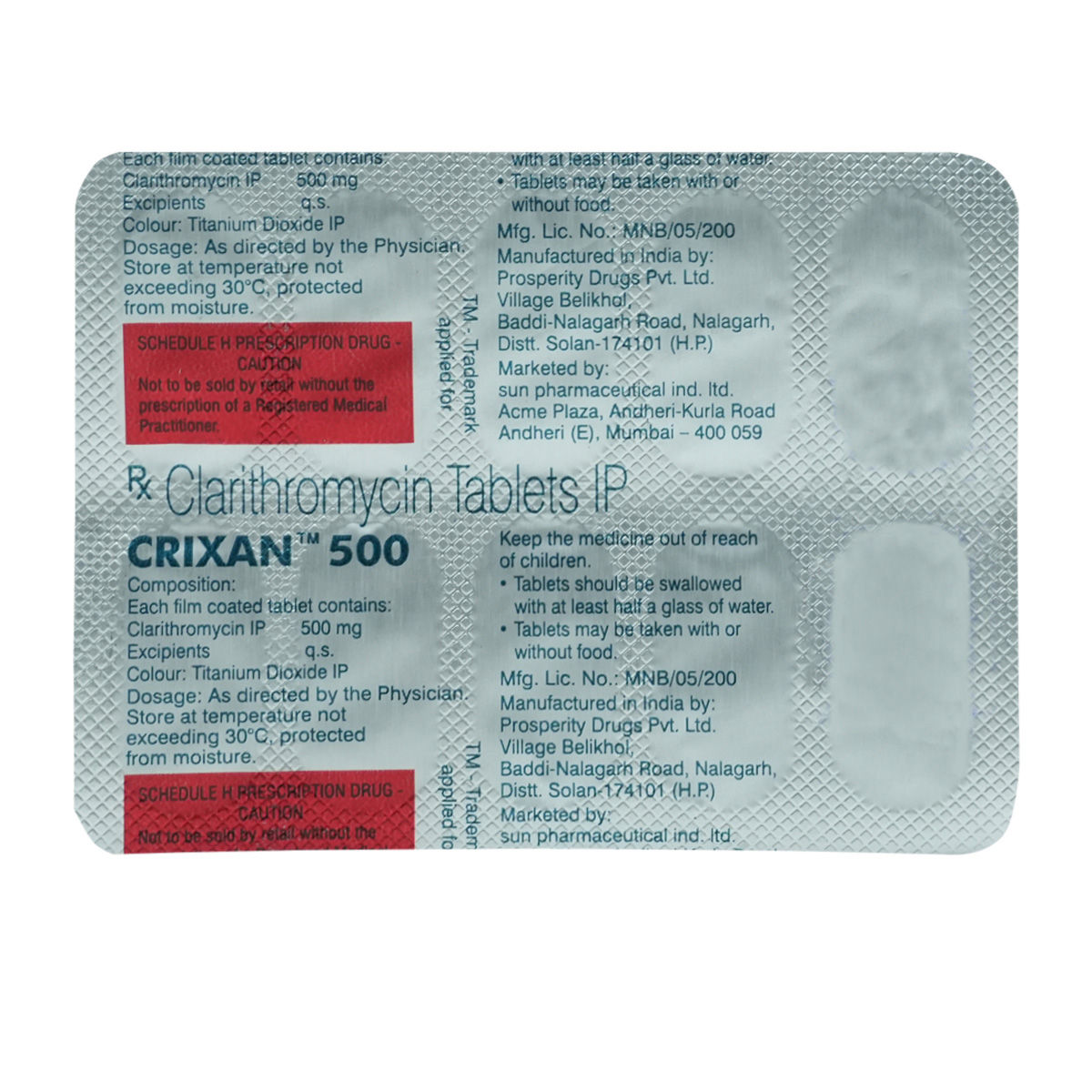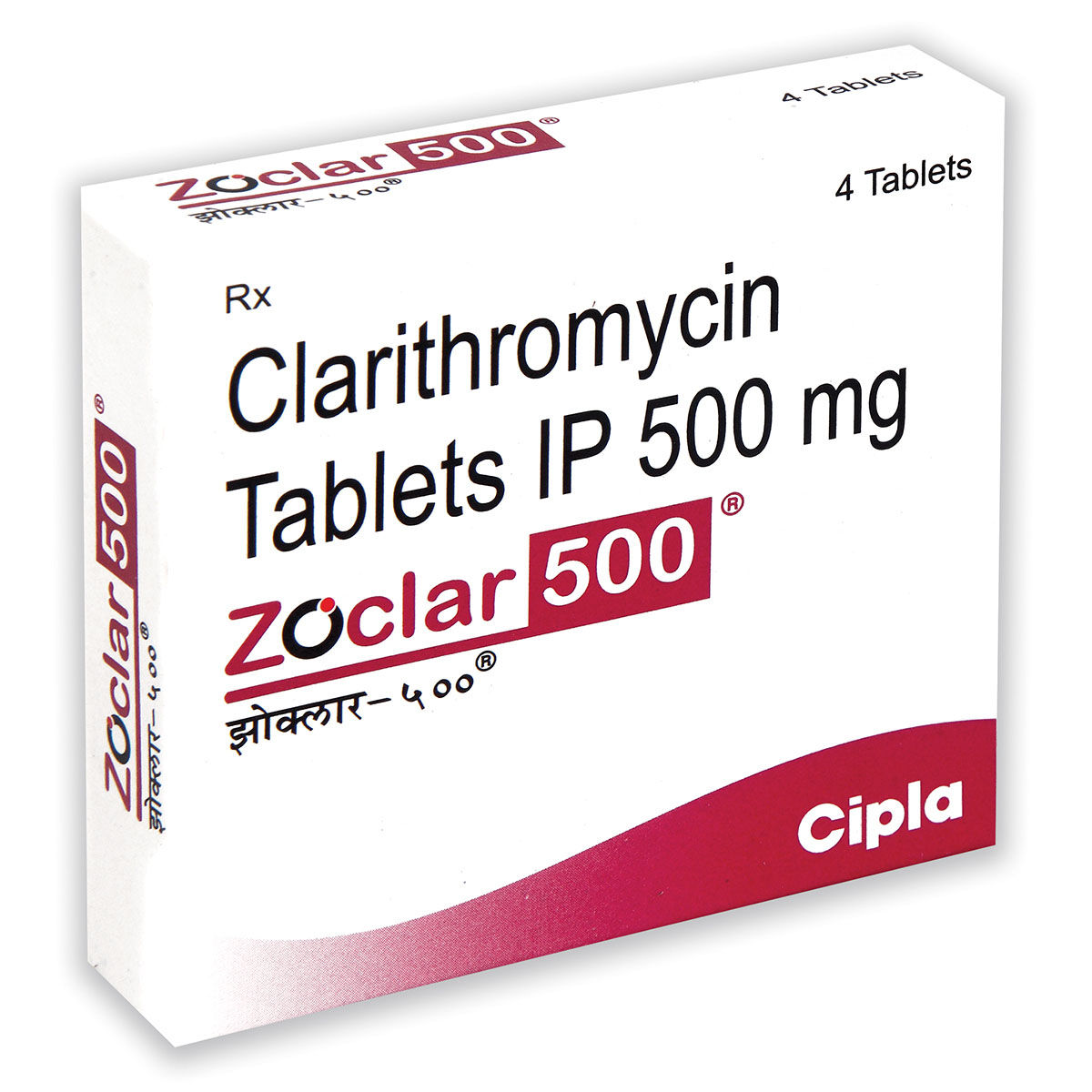Clarima 500 Tablet

₹310
(Inclusive of all Taxes)
₹46.5 Cashback (15%)
Clarima 500 Tablet is used to treat a wide range of bacterial infections, including chest infections such as bronchitis and pneumonia, skin problems such as cellulitis (potentially serious bacterial skin infection, the affected skin appears swollen and red and is typically painful and warm to the touch), and ear infections. Besides this, it is also used in combination with other medicines to treat duodenal ulcers caused by H. pylori. It contains Clarithromycin, which inhibits the growth of bacteria. It may cause some common side effects, such as nausea, diarrhoea, vomiting, loss of appetite, bloating, indigestion, headaches and difficulty sleeping. Before taking this medicine, you should tell your doctor if you are allergic to any of its components or if you are pregnant/breastfeeding, and about all the medications you are taking and pre-existing medical conditions.
Know Your Delivery Time
Provide Delivery Location
 Prescription drug
Prescription drugWhats That

Secure Payment

India's Most Trusted Pharmacy

Genuine Products
About Clarima 500 Tablet
Clarima 500 Tablet is used to treat a wide range of bacterial infections, including chest infections such as bronchitis and pneumonia, skin problems such as cellulitis (potentially serious bacterial skin infection, the affected skin appears swollen and red and is typically painful and warm to the touch), and ear infections. Besides this, Clarima 500 Tablet is also used in combination with other medicines to treat duodenal ulcers caused by H. pylori.
Clarima 500 Tablet contains Clarithromycin (antibiotic). It inhibits the protein synthesis process required for the growth of the bacterial cell. As a result, bacterial cells are not able to reproduce and grow. Thus, Clarima 500 Tablet helps prevent infections.
Clarima 500 Tablet should only be if your doctor has prescribed it to you. Clarima 500 Tablet should not be stopped even if you feel better as it is an antibiotic medication, and completing the full course is necessary; otherwise, the infection might reappear in a more severe form. Like all medicines, Clarima 500 Tablet may cause some common side effects, including feeling sick (nausea), diarrhoea, being sick (vomiting), loss of appetite, bloating, indigestion, headaches, and difficulty sleeping. These side effects are temporary and may get resolve after some time; however, if these side effects persists, let your doctor know about this.
Do not take Clarima 500 Tablet if allergic to azithromycin, other macrolide antibiotics, or any components present in Clarima 500 Tablet. Clarima 500 Tablet isn't normally recommended during pregnancy and while breastfeeding. But your doctor may prescribe it if the benefits of taking it are greater than the risks. Before using the Clarima 500 Tablet, tell your doctor if you ever had an allergy to Clarima 500 Tablet have kidney problems, liver problems, a swollen food pipe (oesophagitis), lupus disease (an autoimmune disease), or muscle disease (myasthenia gravis).
Uses of Clarima 500 Tablet
Clarima 500 Tablet is used in the treatment of Bacterial infections. The detailed uses of Clarima 500 Tablet are as follows:<br/> • Treatment of Respiratory Infections: Clarima 500 Tablet is commonly prescribed to treat respiratory infections such as bronchitis and pneumonia caused by susceptible bacteria.<br/> • Skin Infections: Clarima 500 Tablet effectively treats skin infections like cellulitis or impetigo, caused by bacterial pathogens.<br/> • Sinusitis: Clarima 500 Tablet is used to manage acute bacterial sinusitis, relieving symptoms like nasal congestion and facial pain caused by bacterial infections.<br/> • Otitis Media: Clarima 500 Tablet is frequently utilized to treat middle ear infections (otitis media), providing relief from ear pain and inflammation.<br/>
Directions for Use
- Clarima 500 Tablet can be taken with or without food or as advised by your doctor.
- Follow your doctor's instructions on the dosage and timing of this medication.
- Swallow Clarima 500 Tablet as a whole with a glass of water.
- Do not crush, break, or chew it.
Medicinal Benefits
Clarima 500 Tablet is a type of macrolide class of antibiotic which is effective against a wide range of bacteria, including gram-negative and gram-positive bacteria, anaerobes, and some parasites (like Balantidium coli and Entamoeba species). It is prescribed for treating various bacterial infections, including chest infections such as pneumonia, skin problems such as cellulitis, and ear infections; on the other hand, It is also used in combination with other medicines to treat duodenal ulcers caused by H. pylori (Helicobacter pylori). Clarima 500 Tablet is sometimes used by people who have an allergy to penicillin and antibiotics similar to penicillin, such as amoxicillin.
How Clarima 500 Tablet Works
Storage
- Drink plenty of fluids and consider oral rehydration solutions.
- Eat bland, easily digestible foods like bananas, rice, toast, and applesauce.
- Avoid trigger foods like greasy, spicy, fatty, acidic, and caffeinated foods.
- Gradually reintroduce fiber-rich foods as symptoms improve.
- Get adequate sleep and rest.
- Practice relaxation techniques to manage stress.
- Maintain regular bowel habits.
- Avoid overexertion and take breaks when needed.
- Consult a doctor if your gastrointestinal symptoms are severe, persistent, or accompanied by fever, bloody stools, dehydration, or last for more than a few days.
- Regularly brush and floss your teeth.
- Rinse your mouth with water and baking soda a solution to neutralize acid in the mouth. This makes your food taste as it should.
- Drink plenty of water or non-caffeinated drinks to prevent dry mouth which may lead to altered taste.
- Try ginger, peppermint, fruit or green teas, lemonade, ginger ale or fruit juice to help mask unpleasant tastes.
- Try sucking on sugar-free ice pops or ice cubes to prevent dry mouth.
- Use a warm compress on the affected area to help reduce discomfort.
- Elevate the affected limb above heart level.
- Remove the IV catheter (if applicable) and reinsert at a different site.
- Consult your healthcare provider if symptoms are severe or persist.
- Inform Your Doctor: Notify your doctor immediately about your diarrhoea symptoms. This allows them to adjust your medication or provide guidance on managing side effects.
- Stay Hydrated: Drink plenty of fluids to replace lost water and electrolytes. Choose water, clear broth, and electrolyte-rich drinks. Avoid carbonated or caffeinated beverages to effectively rehydrate your body.
- Follow a Bland Diet: Eat easy-to-digest foods to help firm up your stool and settle your stomach. Try incorporating bananas, rice, applesauce, toast, plain crackers, and boiled vegetables into your diet.
- Avoid Trigger Foods: Steer clear of foods that can worsen diarrhoea, such as spicy, fatty, or greasy foods, high-fibre foods, and dairy products (especially if you're lactose intolerant).
- Practice Good Hygiene: Maintain good hygiene to prevent the spread of infection. To stay healthy, wash your hands frequently, clean and disinfect surfaces regularly, and avoid exchanging personal belongings with others.
- Take Anti-Diarrheal Medications: If your doctor advises, anti-diarrheal medications such as loperamide might help manage diarrhoea symptoms. Always follow your doctor's directions.
- Keep track of your diarrhoea symptoms. If they don't get better or worse or are accompanied by severe stomach pain, blood, or dehydration signs (like extreme thirst or dark urine), seek medical help.
- Inform your doctor about the nausea and discuss possible alternatives to the medication or adjustments to the dosage.
- Divide your daily food intake into smaller, more frequent meals to reduce nausea.
- Opt for bland, easily digestible foods like crackers, toast, plain rice, bananas, and applesauce.
- Avoid certain foods that can trigger nausea, such as fatty, greasy, spicy, and smelly foods.
- Drink plenty of fluids, such as water, clear broth, or electrolyte-rich beverages like coconut water or sports drinks.
- Use ginger (tea, ale, or candies) to help relieve nausea.
- Get adequate rest and also avoid strenuous activities that can worsen nausea.
- Talk to your doctor about taking anti-nausea medication if your nausea is severe.
- Record when your nausea occurs, what triggers it, and what provides relief to help you identify patterns and manage your symptoms more effectively.
- Preventing Vomiting (Before it Happens)
- Take medication exactly as prescribed by your doctor. This can help minimize side effects, including vomiting.
- Having a small meal before taking your medication can help reduce nausea and vomiting.
- Talk to your doctor about taking anti-nausea medication along with your prescribed medication.
- Managing Vomiting (If it Happens)
- Try taking ginger in the form of tea, ale, or candy to help alleviate nausea and vomiting.
- What to Do if Vomiting Persists
- Consult your doctor if vomiting continues or worsens, consult the doctor for guidance on adjusting your medication or additional treatment.
- Drink water or other clear fluids.
- To prevent worsening of pain, limit intake of tea, coffee, or alcohol.
- Include bland foods like rice, toast, crackers, and rice in your diet.
- Avoid lying down immediately after eating as it may cause indigestion or heartburn.
- Avoid acidic and spicy food as it may cause indigestion.
What if I have taken an overdose of Clarima 500 Tablet
Drug Warnings
Avoid taking Clarima 500 Tablet if you are allergic to the medicine or any other components present in it. Iron and antacids (like magnesium hydroxide and aluminium hydroxide) may bind to Clarima 500 Tablet in the gastrointestinal tract, lowering its efficiency. So, a gap of at least 2 hours should be maintained between intake of Clarima 500 Tablet and iron supplements and antacids. Besides this, in some cases, the use of Clarima 500 Tablet causes antibiotic-associated diarrhoea. Clarima 500 Tablet may cause sensitive skin to sunlight and ultraviolet rays, causing an exaggerated sunburn reaction. Hence, it is advisable to apply sunscreen before going outside. Its use has also been associated with an increased risk of fungal skin infections like vaginal candidiasis (thrush). Tetracycline and Clarima 500 Tablet can form a stable calcium complex in bone-forming tissue, thereby affecting the growth of fibula bones in young children and bone development in the fetus. Using a Clarima 500 Tablet with isotretinoin should be avoided as it has been reported to cause pseudotumor cerebri (increased pressure inside the brain). Long-term use of Clarima 500 Tablet may affect your blood, kidney, and liver health, so yearly diagnostic tests of these parameters is recommended.
Drug-Drug Interactions
Drug-Drug Interactions
Login/Sign Up
When Clarima 500 Tablet is taken with Saquinavir, increases the risk of an irregular heart rhythm.
How to manage the interaction:
Co-administration of Clarima 500 Tablet and Saquinavir can lead to an interaction, it can be taken if advised by a doctor. However, if you experience any symptoms like dizziness, lightheadedness, fainting, shortness of breath, or heart palpitations, consult a doctor immediately. Do not stop using any medications without a doctor's advice.
Taking Clarima 500 Tablet with Lovastatin can increase the risk of muscle problems.
How to manage the interaction:
Co-administration of Clarima 500 Tablet and Lovastatin can lead to an interaction, it can be taken if advised by a doctor. However, if you experience any symptoms like fever, chills, joint pain or swelling, unusual bleeding or bruising, skin rash, itching, loss of appetite, fatigue, nausea, vomiting, dark-colored urine, and/or yellowing of the skin or eyes, consult a doctor immediately. Do not stop using any medications without a doctor's advice.
When Cabergoline is taken with Clarima 500 Tablet, the amount of Cabergoline in the blood can go up.
How to manage the interaction:
Taking Cabergoline with Clarima 500 Tablet is not recommended, please consult your doctor before taking it. They can be taken together if advised by your doctor. However, contact your doctor if you experience any symptoms. Do not stop taking any medications without consulting a doctor.
When Dronedarone is taken with Clarima 500 Tablet, can increase the blood levels of dronedarone and cause an irregular heart rhythm that may be serious.
How to manage the interaction:
Taking Clarima 500 Tablet with Dronedarone can result in an interaction, it should be taken only if a doctor has advised it. However, if you experience dizziness, lightheadedness, fainting, shortness of breath, or heart palpitation, contact a doctor immediately. Do not discontinue any medications without consulting a doctor.
When Flibanserin is taken with Clarima 500 Tablet, it can slow down the way Flibanserin is broken down in the body.
How to manage the interaction:
Co-administration of Clarima 500 Tablet and Flibanserin can lead to an interaction, it can be taken if advised by a doctor. However, if you experience any symptoms like excessive drowsiness and decreases in blood pressure that can lead to dizziness, lightheadedness, or fainting, consult a doctor immediately. Do not stop using any medications without a doctor's advice.
When Ranolazine and Clarima 500 Tablet are taken together, significantly increases the blood levels and effects of Ranolazine.
How to manage the interaction:
Co-administration of Clarima 500 Tablet and Ranozaline can lead to an interaction, it can be taken if advised by a doctor. Do not stop using any medications without a doctor's advice.
Coadministration of colchicine with Clarima 500 Tablet may increase the blood levels of colchicine, increasing the risk of serious side effects.
How to manage the interaction:
Taking Colchicine with Clarima 500 Tablet is not recommended, they can be taken together if advised by your doctor. However, contact your doctor if you experience abdominal pain, nausea, vomiting, diarrhea, fever, muscle pain, weakness, fatigue, and/or numbness or tingling in your hands and feet. Do not stop taking any medications without consulting a doctor.
Combining Clarima 500 Tablet with Pimozide can increase the risk of heart rhythm problems.
How to manage the interaction:
Co-administration of Clarima 500 Tablet and Pimozide can lead to an interaction, it can be taken if advised by a doctor. However, if you experience any symptoms like irregular heartbeat, chest tightness, blurred vision or nausea, consult a doctor immediately. Do not stop using any medications without a doctor's advice.
When Terfenadine is taken with Clarima 500 Tablet, the amount of Terfenadine in the blood can go up.
How to manage the interaction:
Co-administration of Clarima 500 Tablet and Terfenadine can lead to an interaction, it can be taken if advised by a doctor. However, if you experience any symptoms like dizziness, lightheadedness, fainting, shortness of breath, or heart palpitations, consult a doctor immediately. Do not stop using any medications without a doctor's advice.
Using Lurasidone together with Clarima 500 Tablet may result in significantly higher Lurasidone blood levels. This may increase the possibility of side effects like Parkinson's disease. (It is a brain disorder that produces uncontrollable movements.)
How to manage the interaction:
While Lurasidone and Clarima 500 Tablet may interact, they can be used if prescribed by a doctor. Consult a doctor if you have any abnormal muscle activity, fits, high blood sugar, high sugars, high cholesterol, heat intolerance or heat stroke, dizziness, lightheadedness, headache, flushing, fainting, or heart palpitations. Do not discontinue any medications without consulting a doctor.
Drug-Food Interactions
Drug-Food Interactions
Login/Sign Up
Grapefruit Juice
How to manage the interaction:
Grapefruit juice may delay the gastrointestinal absorption of Clarima 500 Tablet. Avoid grapefruit juice while on treatment with Clarima 500 Tablet.
Diet & Lifestyle Advise
- Probiotics and prebiotics can also help to reduce the side effects of antibiotics.
- Include more fibre-enriched food in your diet, as it can be easily digested by your gut bacteria, which helps stimulate their growth. Thus, fibre foods may help restore healthy gut bacteria after a course of antibiotics. Whole grains like whole-grain bread and brown rice should be included in your diet.
- Eating grapefruit during antibiotics treatment can prevent the body from utilizing Clarima 500 Tablet properly. So, avoid intake of grapefruit or grapefruit juice with the antibiotic.
- Avoid taking too much calcium, iron-enriched foods and drinks as it might affect the working of Clarima 500 Tablet.
- Avoid intake of alcoholic beverages with Clarima 500 Tablet as it can make you dehydrated and affect your sleep. This can make it harder for your body to aid the Clarima 500 Tablet in fighting off infections.
Habit Forming
Therapeutic Class
Product Substitutes
Alcohol
Consult your doctor
Clarima 500 Tablet should not be taken until prescribed if you are taking alcohol. Keep your doctor informed if you drink alcohol.
Pregnancy
Consult your doctor
Clarima 500 Tablet should be used in pregnant women only if clinically needed, and the benefits outweigh the risks.
Breast Feeding
Consult your doctor
Let your doctor know if you are a nursing mother before taking Clarima 500 Tablet; your doctor will decide whether Clarima 500 Tablet can be taken by breastfeeding mothers or not.
Driving
Consult your doctor
Not enough scientific data available for Clarima 500 Tablet, hence it is advised to consult your doctor.
Liver
Caution
Clarima 500 Tablet to be taken with caution, especially if you have a history of liver diseases/conditions. The dose may have to be adjusted by your doctor.
Kidney
Caution
Clarima 500 Tablet to be taken with caution, especially if you have a history of kidney diseases/conditions. The dose may have to be adjusted by your doctor.
Children
Safe if prescribed
Clarima 500 Tablet can be given safely to children above 6 months of age, with the dose to be adjusted and recommended by a child specialist only.

Have a query?
FAQs
Clarima 500 Tablet is used to treat bacterial infections, including chest infections, skin infections, and ear infections. Besides this, Clarima 500 Tablet is also used in combination with other medicines to treat duodenal ulcers caused by H. pylori.
Clarima 500 Tablet contains Clarithromycin (antibiotic). It inhibits the protein synthesis process required for the growth of the bacterial cell. As a result, bacterial cells are not able to reproduce and grow. Thus, Clarima 500 Tablet helps in the prevention of infections.
You should avoid taking iron supplements, multivitamins, calcium supplements, antacids, or laxatives within 2 hours before or after taking Clarima 500 Tablet. Avoid taking any other antibiotics containing Clarima 500 Tablet unless your doctor has prescribed you.
After taking antibiotics such as Clarima 500 Tablet, some people get thrush, a fungal infection. This is due to the fact that antibiotics kill the regular, harmless bacteria that serve to protect you from thrush.
Clarima 500 Tablet treats only bacterial infections. It will not work for viral infections (such as common cold, flu).
No, Clarima 500 Tablet is a macrolide antibiotic. It can be taken by people who are allergic to penicillin with doctor advice only.
Side-effects are rare with Clarima 500 Tablet and do not usually last long. They will get better after a day or two. if those side effects persist reach out to the doctor immediately.​
No, Clarima 500 Tablet should not be stopped even if you feel better as it is an antibiotic medication and completing the full course if very necessary; otherwise, the infection might re-appear in a more severe form.
Disclaimer
Author Details
We provide you with authentic, trustworthy and relevant information

























